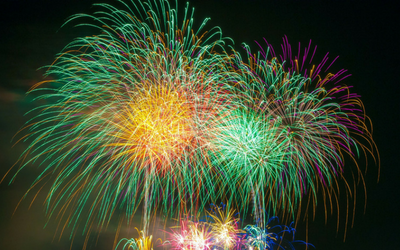
We are getting closer to some of the most anxiety-inducing days in a pet’s life: the fireworks celebrations that happen at the beginning of July. Firework displays, while exciting for humans, can be a source of fear and anxiety for many animals. If you haven’t already taken steps to help your pet during these days, this is your reminder to start. Do not wait until the end of June!
Signs of Firework Phobia
Pets react to fireworks in various ways, and it’s essential to recognize the signs of distress. Common indicators of firework phobia include:
- Trembling or shaking
- Pacing or restlessness
- Excessive barking or meowing
- Hiding or trying to escape
- Panting or drooling
- Destructive behavior
- Loss of appetite
Why Pets Fear Fireworks
Fireworks are loud, unpredictable, and bright. For pets, these characteristics can be terrifying. Animals have more acute hearing than humans, making the sounds of fireworks much more intense for them. The sudden and unpredictable nature of the noise can also trigger a fear response.
Safety Tips During Fireworks
Keep Pets Indoors
Even if your pet normally stays outside, bring them inside during fireworks. The risk of them running away out of fear is high, and indoor environments are typically quieter and safer. Do not take them to a fireworks display! While we want to include our pets in fun family outings, it’s not fair to put them in distress.
Secure Doors and Windows
Ensure all doors, windows, and pet flaps are securely closed to prevent your pet from escaping. Consider closing curtains or blinds to block out the bright flashes.
Check ID
Make sure your pet has up-to-date identification, including a collar with an ID tag and a microchip. If they escape, this increases the chance of being reunited quickly.
Exercise Beforehand
Take your dog for a walk or engage your cat in a play session before the fireworks start. A tired pet will likely be less anxious and more relaxed.
Strategies to Keep Your Pet Calm Indoors
Create a Safe Space
Provide a secure, quiet area where your pet can retreat during the fireworks. This could be a room with few windows, or a cozy crate lined with their favorite blankets. Familiar smells and items can be comforting.
Mask the Sounds
Use background noise to mask the sound of fireworks. Turn on the television, play calming music, or use a white noise machine to help drown out the loud bangs.
Comfort and Reassure
While some pets may prefer to be alone, others find comfort in their owner’s presence. Offer gentle petting and soothing words. However, try not to reinforce fearful behavior by over-coddling.
Consider Calming Products
Ask your veterinary team about products designed to reduce anxiety, including:
- Thundershirts® or anxiety wraps: These snug-fitting garments can provide a sense of security.
- Calming supplements: Supplements containing ingredients like L-theanine or chamomile can help reduce anxiety.
- Pheromone diffusers: Products like Feliway® (for cats) or Adaptil® (for dogs) release calming pheromones.
- Anti-anxiety medication: There are different effective products available, but it is best to test their effects prior to the scary event.
Post-Fireworks Care
Check Your Pet
After the fireworks have ended, check your pet for any signs of injury or continued distress. Offer them water and ensure they feel safe by maintaining their normal routines.
Maintain a Calm Environment
Keep the environment calm and quiet as your pet recovers from the stress of the fireworks. Continue to offer comfort and reassurance.
Monitor Behavior
In the days following the fireworks, monitor your pet’s behavior. If you notice prolonged anxiety or any unusual behaviors, consider consulting your veterinarian for further advice.
Fireworks phobia is a common issue for many pets, but with the right strategies and precautions, you can help make these loud nights more bearable. By creating a safe space, using calming techniques, and ensuring their safety, you can reduce their stress and keep them secure. Remember, the key is preparation and understanding your pet’s needs. Here’s to a safe and happy celebration for everyone, including our furry friends!
